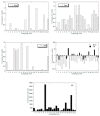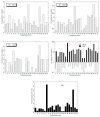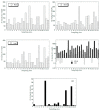Invasive Weed Asystasia gangetica as a Potential Biomonitor and a Phytoremediator of Potentially Toxic Metals: A Case Study in Peninsular Malaysia
- PMID: 33924835
- PMCID: PMC8124176
- DOI: 10.3390/ijerph18094682
Invasive Weed Asystasia gangetica as a Potential Biomonitor and a Phytoremediator of Potentially Toxic Metals: A Case Study in Peninsular Malaysia
Abstract
The invasive weed Asystasia gangetica was investigated for its potential as a biomonitor and as a phytoremediator of potentially toxic metals (PTMs) (Cd, Cu, Ni, Pb, and Zn) in Peninsular Malaysia owing to its ecological resistance towards unfavourable environments. The biomonitoring potential of PTMs was determined based on the correlation analysis of the metals in the different parts of the plant (leaves, stems, and roots) and its habitat topsoils. In the roots, the concentrations (mg/kg dry weight) of Cd, Cu, Ni, Pb, and Zn ranged from 0.03 to 2.18, 9.22 to 139, 0.63 to 5.47, 2.43 to 10.5, and 50.7 to 300, respectively. In the leaves, the concentrations (mg/kg dry weight) of Cd, Cu, Ni, Pb, and Zn ranged from 0.03 to 1.16, 7.94 to 20.2, 0.03 to 6.13, 2.10 to 21.8, and 18.8 to 160, respectively. In the stems, the concentrations (mg/kg dry weight) of Cd, Cu, Ni, Pb, and Zn ranged from 0.03 to 1.25, 5.57 to 11.8, 0.23 to 3.69, 0.01 to 7.79, and 26.4 to 246, respectively. On the other hand, the phytoremediation potential of the five metals was estimated based on the bioconcentration factor (BCF) and the translocation factor (TF) values. Correlation analysis revealed that the roots and stems could be used as biomonitors of Cu, the stems as biomonitors of Ni, the roots and leaves as biomonitors of Pb, and all three parts of the plant as biomonitors of Zn. According to the BCF values, in the topsoil, the "easily, freely, leachable, or exchangeable" geochemical fractions of the five metals could be more easily transferred to the roots, leaves, and stems when compared with total concentrations. Based on the TF values of Cd, Ni, and Pb, the metal transfer to the stems (or leaves) from the roots was efficient (>1.0) at most sampling sites. The results of BCF and TF showed that A. gangetica was a good phytoextractor for Cd and Ni, and a good phytostabilizer for Cu, Pb, and Zn. Therefore, A. gangetica is a good candidate as a biomonitor and a phytoremediator of Ni, Pb, and Zn for sustainable contaminant remediation subject to suitable field management strategies.
Keywords: biomonitoring; invasive weeds; phytoremediation; potentially toxic metals.
Conflict of interest statement
The authors declare no conflict of interest.
Figures











References
-
- Prabakaran K., Li J., Anandkumar A., Leng Z., Zou C.B., Du D. Managing Environmental Contamination through Phytoremediation by Invasive Plants: A Review. Ecol. Eng. 2019;138:28–37. doi: 10.1016/j.ecoleng.2019.07.002. - DOI
-
- Wiart C. Medicinal Plants of South East Asia. Pelanduk Publications; Subang Jaya, Malaysia: 2000.
-
- Kiew R., Vollesen K. Asystasia (Acanthaceae) in Malaysia. Kew Bull. 1997;52:965–971. doi: 10.2307/4117823. - DOI
-
- Hsu T.-W., Chiang T.-Y., Peng J.-J. Asystasia Gangetica (L.) T. Anderson Subsp. Micrantha (Nees) Ensermu (Acanthaceae), A Newly Naturalized Plant in Taiwan. Taiwania. 2005;50:117–122. doi: 10.6165/tai.2005.50(2).117. - DOI
-
- Skinner J. The Invasive Weed Chinese Violet (Asystasia Gangetica Subspecies Micrantha) Now Threatens Northern Australia. Plant Prot. Q. 2015;30:126–132.
Publication types
MeSH terms
Substances
LinkOut - more resources
Full Text Sources
Other Literature Sources
Miscellaneous

